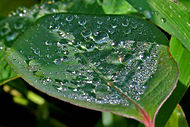- Euphorbia heterophylla
-
Painted Euphorbia 
Scientific classification Kingdom: Plantae (unranked): Angiosperms (unranked): Eudicots (unranked): Rosids Order: Malpighiales Family: Euphorbiaceae Subfamily: Euphorbioideae Tribe: Euphorbieae Subtribe: Euphorbiinae Genus: Euphorbia Species: E. heterophylla Binomial name Euphorbia heterophylla
L.Synonyms Euphorbia cyathophora Murr.
Euphorbia heterophylla, also known under the common names of (Mexican) fireplant, painted euphorbia, desert poinsettia, wild poinsettia, fire on the mountain, paint leaf and kaliko plant, is a plant belonging to the Euphorbiaceae or spurge family. This plant has many synonyms; one of the most common is Euphorbia cyathophora.
Contents
Distribution
It is a native plant of Mexico, and its original distribution includes an area spreading from California to east Texas and to much of Central America.
This plant has spread to South and Southeast Asia, having become a weed in India and Thailand, where it has invaded cotton fields and other agricultural terrain. In Thailand, it is called "ลูกเขยตายแม่ยายทำศพ" (RTGS: Luk Khoei Tai Mai Yai Tham Sop), which literally means 'A funeral of a son-in-law is the responsibility of the mother-in-law".[1]
Introduced for ornamental purposes, it quickly spreads, becoming a common sight by the side of the roads and rural pathways.
Description
It is a hardy, ruderal species, growing between 30 and 70 cm in height. The leaves at the upper end of the stalk, close to the cyathium, have a striking, scarlet red coloration.[2] Leaves are mainly 2-4 lobed and 4–7 cm long by 1.5–3 cm wide. Their contrast with the lower dark green leaves gives this euphorbia most of its common names.
The stalk exudes a toxic milky white sap. The cyathia or false flowers, are located in clusters at the head of the stalk and are yellowish green. They have no petals, the red color being part of the young leaves' coloration. The fruits are small, segmented capsules.
This plant often loses its coloration when it grows wild as a weed. It is resistant to herbicide.[3]
Toxicity
Toxicity is documented in most members of the genus Euphorbia. Individuals sensitive to latex are known to have strong reactions, including dermatitis and anaphylaxis, to the sap exuded by this plant.
References
- ^ "พจนานุกรม ฉบับราชบัณฑิตยสถาน พ.ศ. 2542". ราชบัณฑิตยสถาน. ม.ป.ป.. http://rirs3.royin.go.th/dictionary.asp. Retrieved 15 พฤศจิกายน 2554.
- ^ Good picture of a mainstream variety
- ^ Herbicide Resistant Weeds

This Euphorbia-related article is a stub. You can help Wikipedia by expanding it.

